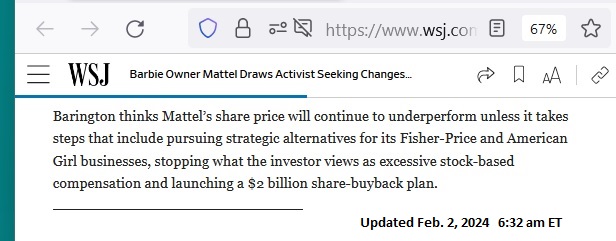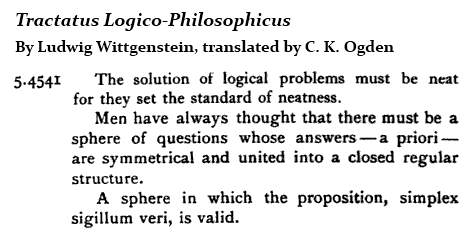


See as well Froebel in this journal.
The Replit code development environment featured
in today's previous post has hosted, for some time now,
an embodiment of the design cube from earlier posts —
Continued from April 2, 2012.
Some predecessors of the Cullinane design cubes of 1984
that lack the Cullinane cubes' symmetry properties—
Kohs cubes (see 1920 article)
Wechsler cubes (see Wechsler in this journal), and
Horowitz cubes (see links below).
An animated GIF that shows the basic unit for
the "design cube" pages at finitegeometry.org —

From a post of Dec. 8, 2010, the (somewhat) related Stella Octangula —
|
You, Xi-lin; Zhang, Peter. "Interality in Heidegger."
The term "interology" is meant as an interventional alternative to traditional Western ontology. The idea is to help shift people's attention and preoccupation from subjects, objects, and entities to the interzones, intervals, voids, constitutive grounds, relational fields, interpellative assemblages, rhizomes, and nothingness that lie between, outside, or beyond the so-called subjects, objects, and entities; from being to nothing, interbeing, and becoming; from self-identicalness to relationality, chance encounters, and new possibilities of life; from "to be" to "and … and … and …" (to borrow Deleuze's language); from the actual to the virtual; and so on. As such, the term wills nothing short of a paradigm shift. Unlike other "logoi," which have their "objects of study," interology studies interality, which is a non-object, a no-thing that in-forms and constitutes the objects and things studied by other logoi. |
Some remarks from this journal on April 1, 2015 —
Manifest O
|
| 83-06-21 | An invariance of symmetry The diamond theorem on a 4x4x4 cube, and a sketch of the proof. |
| 83-10-01 | Portrait of O A table of the octahedral group O using the 24 patterns from the 2×2 case of the diamond theorem. |
| 83-10-16 | Study of O A different way of looking at the octahedral group, using cubes that illustrate the 2x2x2 case of the diamond theorem. |
| 84-09-15 | Diamonds and whirls Block designs of a different sort — graphic figures on cubes. See also the University of Exeter page on the octahedral group O. |
The above site, finitegeometry.org/sc, illustrates how the symmetry
of various visual patterns is explained by what Zhang calls "interality."
WIkipedia on the URL suffix ".io" —
"In computer science, "IO" or "I/O" is commonly used
as an abbreviation for input/output, which makes the
.io domain desirable for services that want to be
associated with technology. .io domains are often used
for open source projects, application programming
interfaces ("APIs"), startup companies, browser games,
and other online services."
An association with the Bead Game from a post of April 7, 2018 —
|
Glasperlenspiel passage quoted here in Summa Mythologica —
“"I suddenly realized that in the language, or at any rate A less poetic meditation on the above 4x4x4 design cube —
"I saw that in the alternation between front and back, See also a related remark by Lévi-Strauss in 1955:
"…three different readings become possible: |
The recent use by a startup company of the URL "interality.io" suggests
a fourth reading for the 1955 list of Lévi-Strauss — in and out —
i.e., inner and outer group automorphisms — from a 2011 post
on the birthday of T. S. Eliot :
A transformation:
Click on the picture for details.

From "Siri + Wechsler" in this journal —
|
For Little Man Tate —
Related material — Wechsler in this journal and
Mark and Lucille, Bill and Violet, Al and Regina,
|
Related material —

". . . It is as if
We had come to an end of the imagination,
Inanimate in an inert savoir.”
— Wallace Stevens, “The Plain Sense of Things”
"In my end . . . ." — T. S. Eliot
|
Thursday, March 22, 2018
The Diamond Cube
|
See a note from Sept. 15, 1984
(perhaps the last day of life for Richard Brautigan).
"Before time began, there was the Cube." — Optimus Prime
See also Design Cube.
* According to The Wall Street Journal … and possibly also
dead on October 11th, according to The New York Times .
![]()
|
“All right, Jessshica. It’s time to open the boxsssschhh.” “Gahh,” she said. She began to walk toward the box, but her heart failed her and she retreated back to the chair. “Fuck. Fuck.” Something mechanical purred. The seam she had found cracked open and the top of the box began to rise. She squeezed shut her eyes and groped her way into a corner, curling up against the concrete and plugging her ears with her fingers. That song she’d heard the busker playing on the train platform with Eliot, “Lucy in the Sky with Diamonds”; she used to sing that. Back in San Francisco, before she learned card tricks. It was how she’d met Benny: He played guitar. Lucy was the best earner, Benny said, so that was mainly what she sang. She must have sung it five times an hour, day after day. At first she liked it but then it was like an infection, and there was nothing she could do and nowhere she could go without it running across her brain or humming on her lips, and God knew she tried; she was smashing herself with sex and drugs but the song began to find its way even there. One day, Benny played the opening chord and she just couldn’t do it. She could not sing that fucking song. Not again. She broke down, because she was only fifteen, and Benny took her behind the mall and told her it would be okay. But she had to sing. It was the biggest earner. She kind of lost it and then so did Benny and that was the first time he hit her. She ran away for a while. But she came back to him, because she had nothing else, and it seemed okay. It seemed like they had a truce: She would not complain about her bruised face and he would not ask her to sing “Lucy.” She had been all right with this. She had thought that was a pretty good deal. Now there was something coming out of a box, and she reached for the most virulent meme she knew. “Lucy in the sky!” she sang. “With diamonds!” • • •
Barry, Max. Lexicon: A Novel (pp. 247-248). |
Related material from Log24 on All Hallows' Eve 2013 —
"Just another shake of the kaleidoscope" —
Related material:
Kaleidoscope Puzzle,
Design Cube 2x2x2, and
Through the Looking Glass: A Sort of Eternity.
From a Log24 post of Feb. 5, 2009 —
An online logo today —
See also Harry Potter and the Lightning Bolt.
The FBI holding cube in "The Blacklist" —
" 'The Front' is not the whole story . . . ."
— Vincent Canby, New York Times film review, 1976,
as quoted in Wikipedia.
See also Solomon's Cube in this journal.
Some may view the above web page as illustrating the
Glasperlenspiel passage quoted here in Summa Mythologica —
“"I suddenly realized that in the language, or at any rate
in the spirit of the Glass Bead Game, everything actually
was all-meaningful, that every symbol and combination of
symbols led not hither and yon, not to single examples,
experiments, and proofs, but into the center, the mystery
and innermost heart of the world, into primal knowledge.
Every transition from major to minor in a sonata, every
transformation of a myth or a religious cult, every classical
or artistic formulation was, I realized in that flashing moment,
if seen with a truly meditative mind, nothing but a direct route
into the interior of the cosmic mystery, where in the alternation
between inhaling and exhaling, between heaven and earth,
between Yin and Yang, holiness is forever being created.”
A less poetic meditation on the above 4x4x4 design cube —
"I saw that in the alternation between front and back,
between top and bottom, between left and right,
symmetry is forever being created."
See also a related remark by Lévi-Strauss in 1955:
"…three different readings become possible:
left to right, top to bottom, front to back."
Related material on automorphism groups —
The "Eightfold Cube" structure shown above with Weyl
competes rather directly with the "Eightfold Way" sculpture
shown above with Bryant. The structure and the sculpture
each illustrate Klein's order-168 simple group.
Perhaps in part because of this competition, fans of the Mathematical
Sciences Research Institute (MSRI, pronounced "Misery') are less likely
to enjoy, and discuss, the eight-cube mathematical structure above
than they are an eight-cube mechanical puzzle like the one below.
Note also the earlier (2006) "Design Cube 2x2x2" webpage
illustrating graphic designs on the eightfold cube. This is visually,
if not mathematically, related to the (2010) "Expert's Cube."
The search for Langlands in the previous post
yields the following Toronto Star illustration —
From a review of the recent film "Justice League" —
"Now all they need is to resurrect Superman (Henry Cavill),
stop Steppenwolf from reuniting his three Mother Cubes
(sure, whatever) and wrap things up in under two cinematic
hours (God bless)."
For other cubic adventures, see yesterday's post on A Piece of Justice
and the block patterns in posts tagged Design Cube.
The Java applets at the webpage "Diamonds and Whirls"
that illustrate Cullinane cubes may be difficult to display.
Here instead is an animated GIF that shows the basic unit
for the "design cube" pages at finitegeometry.org.

Remark on conceptual art quoted in the previous post —
"…he’s giving the concept but not the realization."
A concept — See a note from this date in 1983:
A realization —
Not the best possible realization, but enough for proof of concept .
An image search today for
"Design Cube" + Cullinane:
Click to enlarge (5.3 MB) —

* For the title, see St. Andrew's Day.
The title refers to the previous post, which quotes a
remark by a poetry critic in the current New Yorker .
Scholia —
From the post Structure and Sense of June 6, 2016 —
Structure
Sense
From the post Design Cube of July 23, 2015 —
A note related to the diamond theorem and to the site
Finite Geometry of the Square and Cube —
The last link in the previous post leads to a post of last October whose
final link leads, in turn, to a 2009 post titled Summa Mythologica .
Some may view the above web page as illustrating the
Glasperlenspiel passage quoted here in Summa Mythologica —
“"I suddenly realized that in the language, or at any rate
in the spirit of the Glass Bead Game, everything actually
was all-meaningful, that every symbol and combination of
symbols led not hither and yon, not to single examples,
experiments, and proofs, but into the center, the mystery
and innermost heart of the world, into primal knowledge.
Every transition from major to minor in a sonata, every
transformation of a myth or a religious cult, every classical
or artistic formulation was, I realized in that flashing moment,
if seen with a truly meditative mind, nothing but a direct route
into the interior of the cosmic mystery, where in the alternation
between inhaling and exhaling, between heaven and earth,
between Yin and Yang, holiness is forever being created.”
A less poetic meditation on the above web page* —
"I saw that in the alternation between front and back,
between top and bottom, between left and right,
symmetry is forever being created."
Update of Sept. 5, 2016 — See also a related remark
by Lévi-Strauss in 1955: "…three different readings
become possible: left to right, top to bottom, front
to back."
* For the underlying mathematics, see a June 21, 1983, research note.
For Aaron Sorkin and Walter Isaacson —
Related material —
Bauhaus Cube, Design Cube, and
Nabokov's Transparent Things .
The title refers to actress Kristen Wiig. (See Getcha.)
For Wiig, a scene from a 1968 Ingmar Bergman parody…
… and parts of a post from Saturday night, July 18, 2015 —
Some related material from pure mathematics — Design Cube (July 23).
Continued from yesterday, the date of death for German
billionaire philanthropist Klaus Tschira —
For Tschira in this journal, see Stiftung .
For some Würfel illustrations, see this morning's post
Manifest O. A related webpage —
A sequel to the 1974 film
Thunderbolt and Lightfoot :
Contingent and Fluky
Some variations on a thunderbolt theme:
These variations also exemplify the larger
Verbum theme:


A search today for Verbum in this journal yielded
a Georgetown University Chomskyite, Professor
David W. Lightfoot.
"Dr. Lightfoot writes mainly on syntactic theory,
language acquisition and historical change, which
he views as intimately related. He argues that
internal language change is contingent and fluky,
takes place in a sequence of bursts, and is best
viewed as the cumulative effect of changes in
individual grammars, where a grammar is a
'language organ' represented in a person's
mind/brain and embodying his/her language
faculty."
Some syntactic work by another contingent and fluky author
is related to the visual patterns illustrated above.
See Tecumseh Fitch in this journal.
For other material related to the large Verbum cube,
see posts for the 18th birthday of Harry Potter.
That birthday was also the upload date for the following:
See esp. the comments section.
Or: The Confessions of Nat Tate
“A convincing lie is, in its own way, a tiny, perfect narrative.”
— William Boyd, “A Short History of the Short Story” (2006)
“A novel written in the first-person singular has certain powerful
narrative advantages, especially when it takes the form of a ‘confession.'”
— William Boyd, “Memoir of a Plagiarist” (1994)
From a Log24 post yesterday —
For Little Man Tate —

Related material — Wechsler in this journal and an earlier Siri Hustvedt
art novel, from 2003 —
Mark and Lucille, Bill and Violet, Al and Regina, etc., etc., etc. —

The title is from an essay by James C. Nohrnberg—
"Just another shake of the kaleidoscope" —
Related material:
Kaleidoscope Puzzle,
Design Cube 2x2x2, and
Through the Looking Glass: A Sort of Eternity.
''Most people make the mistake of thinking design is what it looks like,''
says Steve Jobs, Apple's C.E.O. ''People think it's this veneer—
that the designers are handed this box and told, 'Make it look good!'
That's not what we think design is. It's not just what it looks like and feels like.
Design is how it works.''
— "The Guts of a New Machine," by Rob Walker,
New York Times Magazine , Sunday, Nov. 30, 2003

|
See also, from the day of the above Anything Box review—
St. Peter's Day, 2011— two Log24 posts—
The Shattered Mind and Rome After Dark.
Related boxes… Cosmic Cube and Design Cube.
An Adamantine View of "The [Philosophers'] Stone"
The New York Times column "The Stone" on Sunday, Nov. 21 had this—
"Wittgenstein was formally presenting his Tractatus Logico-Philosophicus , an already well-known work he had written in 1921, as his doctoral thesis. Russell and Moore were respectfully suggesting that they didn’t quite understand proposition 5.4541 when they were abruptly cut off by the irritable Wittgenstein. 'I don’t expect you to understand!' (I am relying on local legend here….)"
Proposition 5.4541*—

Related material, found during a further search—
A commentary on "simplex sigillum veri" leads to the phrase "adamantine crystalline structure of logic"—

For related metaphors, see The Diamond Cube, Design Cube 2x2x2, and A Simple Reflection Group of Order 168.
Here Łukasiewicz's phrase "the hardest of materials" apparently suggested the commentators' adjective "adamantine." The word "diamond" in the links above refers of course not to a material, but to a geometric form, the equiangular rhombus. For a connection of this sort of geometry with logic, see The Diamond Theorem and The Geometry of Logic.
For more about God, a Stone, logic, and cubes, see Tale (Nov. 23).
* 5.4541 in the German original—
Die Lösungen der logischen Probleme müssen einfach sein,
denn sie setzen den Standard der Einfachheit.
Die Menschen haben immer geahnt, dass es
ein Gebiet von Fragen geben müsse, deren Antworten—
a priori—symmetrisch, und zu einem abgeschlossenen,
regelmäßigen Gebilde vereint liegen.
Ein Gebiet, in dem der Satz gilt: simplex sigillum veri.
Here "einfach" means "simple," not "neat," and "Gebiet" means
"area, region, field, realm," not (except metaphorically) "sphere."
The Diamond 16 Puzzle and the Kaleidoscope Puzzle can now be downloaded in the normal way from a browser, with the save-as web-page-complete option, and have their JavaScript still work— if the files are saved with the name indicated in the instructions on the puzzles' web pages. (There was a problem with file names in the JavaScript that has been fixed.)
The JavaScript pages Design Cube 2x2x2 and Design Cube 4x4x4 have not been changed. To download these, it is necessary to…
The result is a folder containing both image files and the HTML page, just as it is on the Web.
Through the
Looking Glass:
A Sort of Eternity
From the new president’s inaugural address:
“… in the words of Scripture, the time has come to set aside childish things.”
The words of Scripture:
“through a glass”—
[di’ esoptrou].
By means of
a mirror [esoptron].
Childish things:

Not-so-childish:
Three planes through
the center of a cube
that split it into
eight subcubes:

Through a glass, darkly:
A group of 8 transformations is
generated by affine reflections
in the above three planes.
Shown below is a pattern on
the faces of the 2x2x2 cube
that is symmetric under one of
these 8 transformations–
a 180-degree rotation:
(Click on image
for further details.)
But then face to face:
A larger group of 1344,
rather than 8, transformations
of the 2x2x2 cube
is generated by a different
sort of affine reflections– not
in the infinite Euclidean 3-space
over the field of real numbers,
but rather in the finite Galois
3-space over the 2-element field.

Galois age fifteen,
drawn by a classmate.
These transformations
in the Galois space with
finitely many points
produce a set of 168 patterns
like the one above.
For each such pattern,
at least one nontrivial
transformation in the group of 8
described above is a symmetry
in the Euclidean space with
infinitely many points.
For some generalizations,
see Galois Geometry.
Related material:
The central aim of Western religion–
"Each of us has something to offer the Creator... the bridging of masculine and feminine, life and death. It's redemption.... nothing else matters." -- Martha Cooley in The Archivist (1998) The central aim of Western philosophy– Dualities of Pythagoras as reconstructed by Aristotle: Limited Unlimited Odd Even Male Female Light Dark Straight Curved ... and so on .... “Of these dualities, the first is the most important; all the others may be seen as different aspects of this fundamental dichotomy. To establish a rational and consistent relationship between the limited [man, etc.] and the unlimited [the cosmos, etc.] is… the central aim of all Western philosophy.” — Jamie James in The Music of the Spheres (1993) “In the garden of Adding — The Midrash Jazz Quartet in City of God, by E. L. Doctorow (2000) A quotation today at art critic Carol Kino’s website, slightly expanded: “Art inherited from the old religion — Octavio Paz,”Seeing and Using: Art and Craftsmanship,” in Convergences: Essays on Art and Literature (New York: Harcourt Brace Jovanovich 1987), 52 From Brian O’Doherty’s 1976 Artforum essays– not on museums, but rather on gallery space: “We have now reached
“Space: what you — James Joyce, Ulysses |
Finitegeometry.org Update
(Revised May 21, 2006)
Finitegeometry.org now has permutable JavaScript views of the 2x2x2 and 4x4x4 design cubes. Solomon’s Cube presented a claim that the 4x4x4 design cube retains symmetry under a group of about 1.3 trillion transformations. The JavaScript version at finitegeometry.org/sc/64/view/ lets the reader visually verify this claim. The reader should first try the Diamond 16 Puzzle. The simpler 2x2x2 design cube, with its 1,344 transformations, was described in Diamonds and Whirls; the permutable JavaScript version is at finitegeometry.org/sc/8/view/.
Powered by WordPress